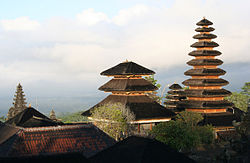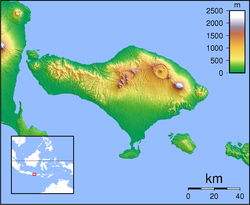- Mother Temple of Besakih
-
Location in Bali; high on Mount AgungPractices
The Mother Temple of Besakih, or Pura Besakih, in the village of Besakih on the slopes of Mount Agung in eastern Bali, is the most important, the largest and holiest temple of Agama Hindu Dharma in Bali.[1], Indonesia and one of a series of Balinese temples.
Contents
History
The temple probably dates to the fourteenth century.
Location
It was built on the south slopes of Mount Agung, the principal volcano of Bali.
Architecture
The temple is actually a complex made up of twenty-two temples that sit on parallel ridges. It has stepped terraces and flights of stairs which ascend to a number of courtyards and brick gateways that lead up to the main spire Meru structure, which is called Pura Penataran Agung. All this is aligned along a single axis and designed to lead the spiritual upward and closer to the mountain which is considered sacred.[2]
The symbolic center or main sanctuary of the complex is the Pura Penataran Agung and and the lotus throne or padmasana is the symbolic center of the main sanctuary and ritual focus of the entire complex. It dates to around the seventeenth century.[3]
A series of eruptions of Mount Agung in 1963, which killed approximately 1,700 people[4][5] also threatened Puru Besakih. The lava flows missed the temple complex by mere meters. The saving of the temple is regarded by the Balinese people as miraculous, and a signal from the gods that they wished to demonstrate their power but not destroy the monument the Balinese faithful had erected.
Festivals
Annually there are at least seventy festivals held at the complex each year since there is a yearly anniversary celebrating almost every shrine. This yearly cycle is based on the 210-day Balinese calendar system.[3]
It had been nominated as a World Heritage Site as early as 1995, but remains unvested.[6]
See also
External links
Besakih travel guide from Wikitravel
Notes
- ^ "Mount Agung and Pura Besakih". Sacred Destinations. http://www.sacred-destinations.com/indonesia/mt-agung-pura-besakih. Retrieved 2010-07-20.
- ^ Mitchell, George (1998). The Hindu temple: an introduction to its meaning and forms. University of Chicago Press. p. 168. ISBN 0226532305.
- ^ a b Davison, Julian (2003). Introduction to Balinese architecture. Tuttle Publishing. p. 60. ISBN 0794600719.
- ^ "Geology of Mt.Agung". Pusat Vulkanologi & Mitigasi Bencana Geologi — VSI. http://www.vsi.esdm.go.id/volcanoes/agung/geology.html. Retrieved 2009-04-26.[dead link]
- ^ Zen, M. T.; Hadikusumo, Djajadi (12/1964). "Preliminary report on the 1963 eruption of Mt.Agung in Bali (Indonesia)". The SAO/NASA Astrophysics Data System. http://adsabs.harvard.edu/abs/1964BVol...27..269Z. Retrieved 2009-04-26.
- ^ "Besakih — UNESCO World Heritage Centre". Tentative Lists. United Nations Educational, Scientific and Cultural Organization. 1995-10-19. http://whc.unesco.org/en/tentativelists/296/. Retrieved 2009-04-27.
Further reading
- I Nyoman Darma Putra and Michael Hitchcock (2005) Pura Besakih: A world heritage site contested in Indonesia and the Malay World, Volume 33, Issue 96 July 2005, pages 225 - 238
- Stuart-Fox, David J.(2002) Pura Besakih: temple, religion and society in Bali KITLV, Original from the University of Michigan (Digitized 5 Sep 2008 into Google Books) ISBN 9067181463, 9789067181464 . 470 pages
Hinduism Portal Hindu temples in Indonesia Candi of Indonesia · Trowulan · Candi Asu · Candi Cetho · Candi Kidal · Candi Sukuh · Candi Surawana · Dieng Plateau · Garuda Wisnu Kencana · Gebang · Gedong Songo · Gunung Kawi · Mother Temple of Besakih · Prambanan · Pura Bratan · Pura Luhur · Pura Gede Perancak · Sambisari · Tanah Lot
Coordinates: 8°22′35″S 115°31′01″E / 8.3764°S 115.517°E
Architecture of Indonesia Religious architecture Ancient monuments of Java • Candi • Dieng temples • Borobudur • Prambanan • Candi Sukuh • Balinese temples • Javanese mosque architectureRumah adat
(the traditional vernacular)Balinese • Enggano • Gayonese • Javanese • Minangkabau • Aceh • Nias • Batak • Toraja • Banjar • Sasak • Mentawai • Dayak • Sumba • PapuanPalaces Javanese palaces • Kraton KasepuhanDutch colonial Post independence & contemporary architecture Post independence architecture in Indonesia • Jengki style • Resort and villa architecture in IndonesiaCategory Categories:- Balinese temples
- Hindu temples in Indonesia
- Indonesian building and structure stubs
- Hindu temple stubs
Wikimedia Foundation. 2010.









